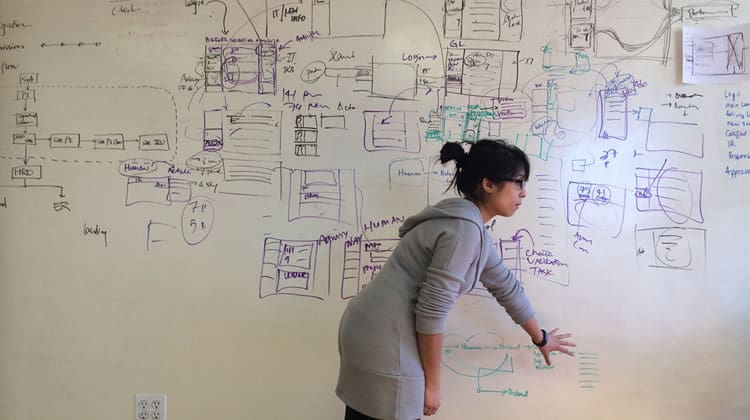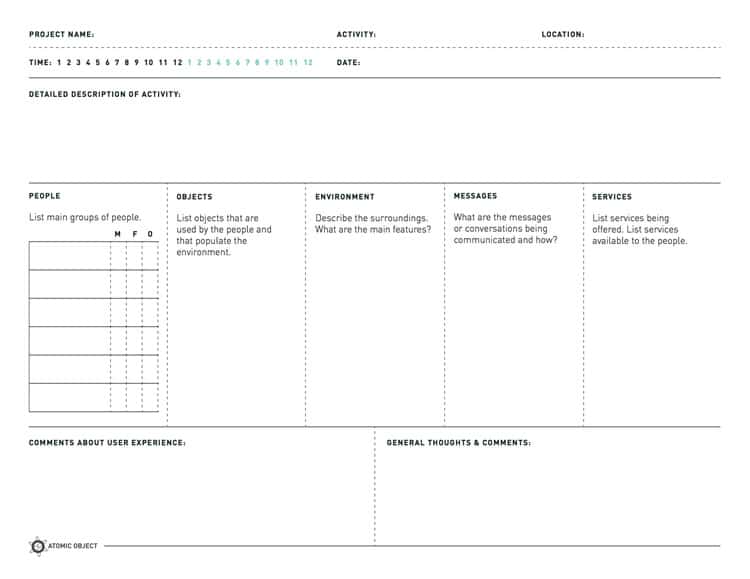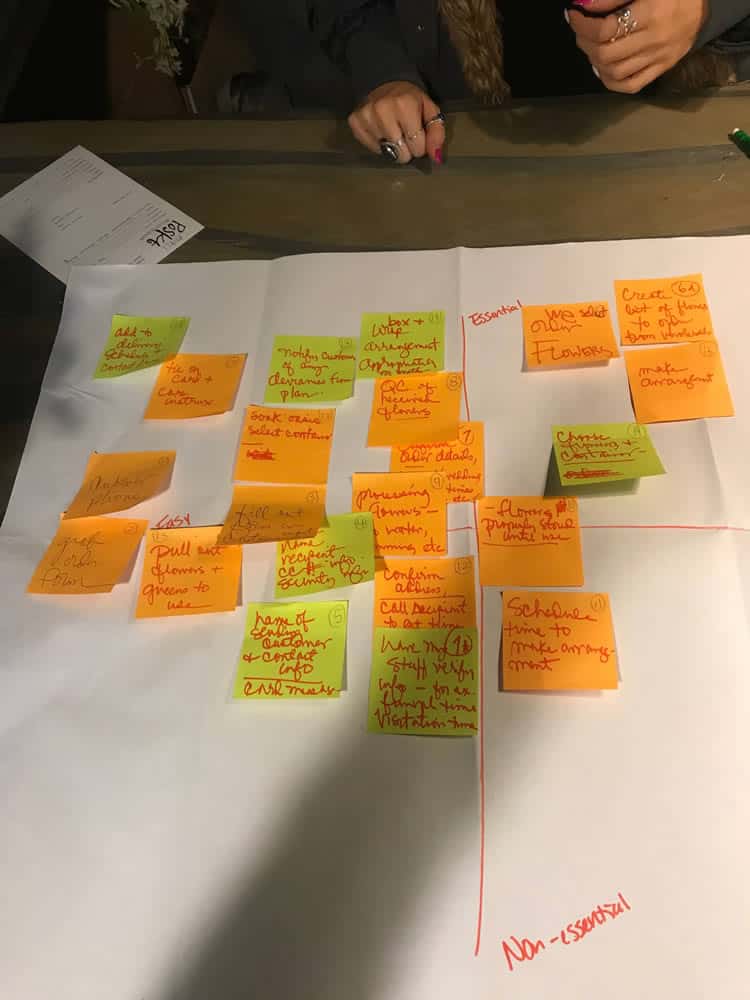
When you search for an image of a ‘UX designer’, you will likely get results depicting the same handful of scenes. You will probably get a bespectacled man hunched at a desk, sketching wireframes in a grid-lined notepad. Alternatively, you might get a bespectacled woman pensively studying a wall papered in post-its. You are also likely to get a group of glasses-wearing coworkers conferring in front of a scribbled whiteboard. Quite frankly I do not know why stock image photographers seem to think all designers have poor eyesight.
These are the scenes that come to mind when we consider the day-to-day work of a designer. However, in reality, UXers are not always tethered to a Macbook or confined to the conference room. Their workdays are much more kinetic, flitting between focus groups, interviews, design workshops, and yes, on-site research.
On-site research, as the name suggests, entails the UX designer escaping the chains of their desk and visiting the actual environment their product is (or will be) used in. When properly conducted, it offers an invaluable source of practical insight that cannot be gained from designing in a cubicle. Improperly performed, it can be a costly waste of time in a project cycle, especially in one that is defined by tight deadlines.
So to help you fully leverage on-site research, I asked Codal‘s top user experience designers to offer their tips, tricks, and best practices for getting the most out of on-site user research.
Why Do On-Site Research At All?
I have mentioned that on-site research provides design data points and perspectives that are not available from even the most in-depth interviews or surveys. However, the most valuable gift on-site research offers is context. Genuinely usable, beautiful products are not designed in a vacuum, because user experience design cannot exist in isolation.
Seeing their product applied in its natural environment gifts the designers with real-world context. They can spot pain points and areas of opportunities that the users themselves may not be conscientious of.
When I requested an example of this while interviewing one of Codal’s UXers for this article, they turned the table and asked me how I communicate with the nearby members of my team. Purely electronically, through Slack? Did I ever just get up and walk the few feet to my manager’s office for person-to-person verbal communication? How might that affect, say, a messaging feature for a company’s internal platform? It is small details like these that I would never have noticed or considered, but do not escape the watchful eye of a UX researcher.

In short, observing your product “in the real world” not only helps inform the design process but can also expedite it. While years of experience and industry best practices make excellent guidelines, every project is different. Better research means a smarter design process, which helps UXers eliminate guesswork, reduce iteration, and solve the problem at hand faster.
When To Do On-Site Research
Geographic location and timeline permitting, the ideal answer is always. However, like everything else in this industry, the more realistic response is an equivocal ‘it depends on the project’.
Products whose usage is constrained to a relatively limited environment make excellent candidates for on-site research. Think most internal, employee-facing platforms, whose users are restricted to a company’s staff.
As you might expect, projects that may not call for on-site research typically have large scopes or environments. That being said, this does not mean on-site research should be ignored full stop.
Best Practices
Now that you are convinced why on-site research is so important, and have identified how appropriate is for your current project, we can get to the good stuff: how do you conduct this research most efficiently and effectively?
1. Prepare
Like the design process itself, it begins with extensive preparation. Do not go into an on-site visit blindly and generate questions on the fly. That is a recipe for ineffective research of all types. So prepare questions ahead of time, and confer with the client to brainstorm and author guidelines or a checklist to keep the on-site visit focused and aligned. Some questions that should be on your list include:
- What makes this space/environment unique?
- What are the current pain points/problems are users experiencing?
- Are they doing any workarounds to solve those problems? What are they? How efficient are they?
- How do people interact with each other?
Now that you know the questions you would like to answer, you are better equipped to identify where opportunities exist to solve a problem. Many more questions may arise during your on-site visit, but these base ones ensure a solid foundation of research. You are now ready to select a methodology for collecting the data necessary to answer those questions.
2. Use An Observational Framework
The entire purpose of on-site research is to observe and record – a task that can be much harder than it sounds. What should you be paying close attention to, and what should be ignored? How do you separate signal from noise?
To answer these fundamental questions, many UX researchers turn to an observational framework, a method and organisational tool for ensuring critical user data is identified and captured appropriately, over all kinds of interactions.
There are all sorts of observational frameworks to choose from, but one of the most common among UX designers (and the one we employ the most at Codal) is POEMS.
POEMS is an excellent framework because of its versatility. It is equally effective if you have fifteen minutes to observe or fifty. It is also recommended for its breadth, which lies right in its acronym:
- People: Roles, positions, behavioral traits, demographics, population
- Objects: What people are interacting with: machines, tools, furniture, etc.
- Environments: Lighting, temperature, architecture, atmosphere
- Messages: Language, verbiage, common phrases, social/professional interactions
- Services: All applications, tools, and other systems that influence the environment
By training your eye on these categories and organising your observations as such, you ensure you do not miss insightful user data and keep your records decluttered and easy to revisit later in the design process. There is no shortage of POEMS worksheet around the web, but you can find a reliable template here.

3. Go Beyond Observation
Depending on the project, you may only be able to observe your participants in their natural environment, without interrupting them for more in-depth inquiries. However, if possible, you should sit down with your subjects and conduct process mapping.
Process mapping, like a standard user interview, involves a one-on-one discussion between the user and UXer about the design problem at hand. However, unlike your typical interview, this one occurs while the user is completing a process, and forces them to write out each step of it.
While process mapping, the user lists each step of a particular task (it could be sending an email, signing up for an account, or any other workflow relevant to your project), and then ranks them by criteria such as difficulty and necessity.

The reason process mapping is so effective is that it makes the user deconstruct a task they likely perform on autopilot and forces them to consider it with an unfamiliar granularity. This can reveal all sorts of valuable insight: what part of this process is complicated, what is not, and what does not need to be a part of it at all.
Get Up, Get Out, And Get Something
On-site research is an indispensable tool in a UX design agency‘s arsenal and can invigorate a project’s discovery phase. It both informs and expedites the design process moving forward, laying the groundwork for future deliverables such as user journeys, feature list creation and prioritisation, and design principles or guidelines.
So for your next project’ discovery phase, unchain yourself from your desk, escape the confines of the conference room, and in the immortal words of OutKast (two masters of design): “you need to get up, get out and get something”.
Want to learn more?
Want to get an industry-recognized Course Certificate in UX Design, Design Thinking, UI Design, or another related design topic? Online UX courses from the Interaction Design Foundation can provide you with industry-relevant skills to advance your UX career. For example, Design Thinking, Become a UX Designer from Scratch, Conducting Usability Testing or User Research – Methods and Best Practices are some of the most popular courses. Good luck on your learning journey!
